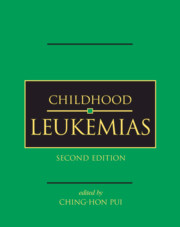Book contents
- Frontmatter
- Contents
- List of contributors
- Preface
- Part I History and general issues
- Part II Cell biology and pathobiology
- 4 Anatomy and physiology of hematopoiesis
- 5 Hematopoietic growth factors
- 6 Signal transduction in the regulation of hematopoiesis
- 7 Immunophenotyping
- 8 Immunoglobulin and T-cell receptor gene rearrangements
- 9 Cytogenetics of acute leukemias
- 10 Molecular genetics of acute lymphoblastic leukemia
- 11 Molecular genetics of acute myeloid leukemia
- 12 Apoptosis and chemoresistance
- 13 Heritable predispositions to childhood hematologic malignancies
- Part III Evaluation and treatment
- Part IV Complications and supportive care
- Index
- Plate Section between pages 400 and 401
- References
9 - Cytogenetics of acute leukemias
from Part II - Cell biology and pathobiology
Published online by Cambridge University Press: 01 July 2010
- Frontmatter
- Contents
- List of contributors
- Preface
- Part I History and general issues
- Part II Cell biology and pathobiology
- 4 Anatomy and physiology of hematopoiesis
- 5 Hematopoietic growth factors
- 6 Signal transduction in the regulation of hematopoiesis
- 7 Immunophenotyping
- 8 Immunoglobulin and T-cell receptor gene rearrangements
- 9 Cytogenetics of acute leukemias
- 10 Molecular genetics of acute lymphoblastic leukemia
- 11 Molecular genetics of acute myeloid leukemia
- 12 Apoptosis and chemoresistance
- 13 Heritable predispositions to childhood hematologic malignancies
- Part III Evaluation and treatment
- Part IV Complications and supportive care
- Index
- Plate Section between pages 400 and 401
- References
Summary
Introduction
Today, acute leukemia in children is managed through the use of risk-adapted therapy, requiring sensitive methods to detect the presence or absence of particular chromosomal abnormalities, one of the most important factors in stratifying patients by risk groups. Identifying genes involved in recurrent chromosomal abnormalities and understanding the roles of these genes in regulating cell growth and inducing malignant transformation can provide important insights into the altered biology of leukemic cells and potentially lead to improved treatment.
In this chapter, I review the most common conventional and molecular cytogenetic characteristics of the childhood acute leukemias and discuss their impact on clinical management strategies. Considerable attention is paid to abnormalities that were only recently identified in the lymphoid and myeloid leukemias, including the fusion genes involving the MLL (11q23), ETV6 (12p13), and CBFA2 (21q22) loci.
Conventional cytogenetics
Standard chromosomal analysis remains the method of choice for the initial screening for karyotypic abnormalities in leukemic cells. Conventional cytogenetic studies detect chromosomal abnormalities only in clones of mitotically active (metaphase) neoplastic cells and are particularly efficient in identifying abnormalities associated with acute leukemias in children and adolescents. These methods detect an abnormal clone in 90% of patients with acute lymphoblastic leukemia (ALL) and 80% of patients with acute myeloid leukemia (AML). They also permit the study of all complex cytogenetic changes present in neoplastic cells, although complementary genetic methods are needed to detect cryptic abnormalities or to evaluate equivocal results.
- Type
- Chapter
- Information
- Childhood Leukemias , pp. 235 - 271Publisher: Cambridge University PressPrint publication year: 2006
References
- 9
- Cited by



